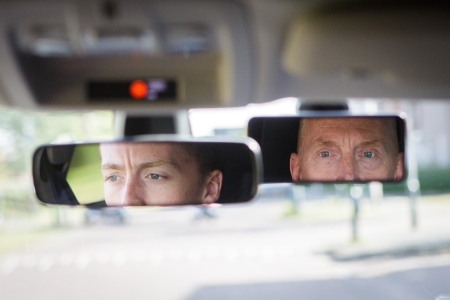In the Netherlands, driver training courses are not bound by rules and, therefore, a great many variants exist. Traditionally, for several months, a candidate takes one or two driving lessons a week. At first, the focus will be on vehicle control and later on road use. Below, a few variants to the traditional driver training methods are described.
Driver training in steps
Driver training in steps (In Dutch: De Rijopleiding In Stappen (RIS)) is a structured approach, developed in co-operation with the Dutch Driving Test Organisation (CBR in Dutch). RIS consists of four modules [37].
The candidate can only start the next module after the previous one has been fully completed. The first module concerns vehicle control, the second simple traffic situations, the third more complex traffic situations and the fourth traffic insight and responsible driving. Candidates are taught by means of so-called scripts: they learn the relevant procedures (first look at this, than that, subsequently do this etc) before actual traffic actions are taken. It is unknown whether candidates having done the RIS have fewer crashes in the first few years after licence acquisition than those who have done a more traditional driver training course.
The intensive driving course
Some driving schools offer intensive driving courses. During this kind of training course a candidate has full-day driving lessons on consecutive days. To pass the driving test, the candidate needs fewer training hours than in the case of traditional training [1]. However, there is evidence to suggest that the crash risk after licence acquisition is higher for candidates having done the intensive driving course than for candidates having done the traditional course [38]. In this case, it may again not be ruled out that self-selection is implicated. Another reason for the lower crash risk after traditional courses may be that slower learning results in a more lasting impact than accelerated learning does [39] [40].
Coaching as teaching method
During traditional training, the candidate receives instructions on how to act and gets feedback. In the European HERMES project [41], however, coaching as a teaching method was investigated. This method does not imply giving instructions but asking questions. The driving instructor will for instance ask candidates: “You want to turn left here, how are you going to do this?” The candidates will say how. The driving instructor will not reply by saying what is right or wrong about their answers, but will only say: “Go ahead.” Having completed the manoeuvre, the candidates will be asked what they could have done better. It is debatable whether coaching is suited to all candidates. It requires candidates to be able to reflect on their own performance. Whether the coaching method results in a lower crash risk after the acquisition of the driving licence is unknown.
